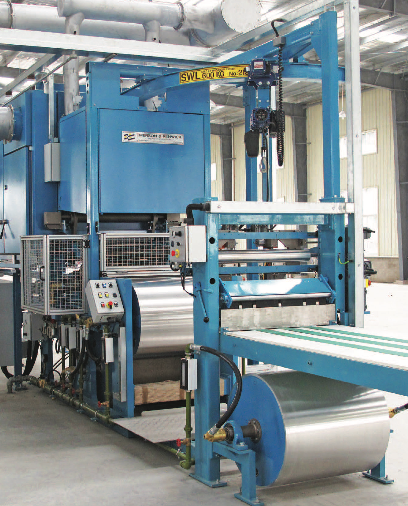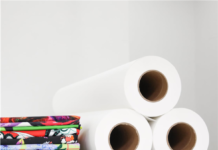Wallpaper is a decorative application to cover walls using canvas or a strong kind of paper to conceal possible ruptures and other imperfections. Contemporary wallpaper has a plastic topcoat and is mainly provided with a graphic image applied by printing. This article appears in the Sign Africa Journal.
In approximately 200 BC, wallpaper was produced and applied in China for the first time. The designs were painted by local prisoners and mainly represented birds, flowers and landscapes.
In the 16th century, the application of wallpaper was discovered in Europe. The painted sheets of approximately 300 x 450mm were imported from China. Around the year 1620, the velvet look and feel was simulated onto wallpaper, afterwards known as flock.
In time, wallpaper application became more popular, and producing wallpaper became a recognised industry. The French enormously influenced wallpaper application and contemporary production processes. A guild existing of decorators and upholsterers, named ‘Dominotiers,’ introduced the block printing technique in Europe. Block printing was originally based in China, where professionals manually cut the designs in the wooden blocks. Next, the image side of the blocks is provided with ink and thereafter printed onto paper. One block represented one colour and one part of the image. Block printing is also a method for printing textiles.
Fifty five years later, French engraver Jean-Michel Papillon invented the contemporary technique to distribute the individual images in both height and width into a certain repeating order (register). The obtained regular image pattern created this way offers a certain harmony. In 1756, he founded a factory to produce wallpaper, offering 300 employees labour and an income. In almost one century, the first reels of wallpaper appeared on the market.
PRESENT TIMES
The wallpaper industry has evolved to the employment of huge production lines. These lines produce wallpaper without interruption reel-to-reel at an average speed of 80 metres per minute. The total length of such a production line may be 30 to 60 metres, depending on the application and the configuration. The cost of a wallpaper production line is between R31 million and R62 million (two and four million Euros).
Wide rolls are being assembled to manageable smaller rolls of approximately 10 metres long and a standard width of 53 centimetres, though they may be wider. The production lines use the conventional print techniques, such as flexo, gravure and screen printing. Flexo in wallpaper is world famous because of its halftones and fine details. Gravure is the solution for even finer halftones.
Instead of conventional flatbed screen printing, rotary screen printing is applied to in these combination lines for the reel-to-reel production of wallpaper. Screen printing excels because of its ability to, for instance, deposit solids, glitters and partial extreme thick coatings, such as a vinyl foam.
THE MARKET
Worldwide, there are approximately 300 wallpaper printing companies, including 200 so-called Chinese barn printers, 50 medium sized printers and another 50 Western and Eastern European quality printers highly valuating the word ‘innovation’. China has the largest population of relatively cheap gravure printed wallpaper producers.
There are several production lines combining the print characteristics of flexo, gravure and screen printing to one combination line. Innovative Western European countries, especially, produce high-quality wallpaper on such combination lines.
Because of the interest in deep embossing of foamed wallpaper, Russia and the former Russian client states are the largest producers of dark coloured foam wallpaper. Engraved and screen printed wallpaper requires huge, horizontal dryers to deeply emboss the foamed wallpaper.
COMBINATION LINES
At present, three leading manufacturers of wallpaper combination lines that offer flexo, gravure and screen printing in one machine are present in Europe. The highly competitive machines may be equipped with the following:
• Flexo, gravure and rotary screen printing, with screen printing as the leading technology.
• Coating.
• Tools to print into different repeat sizes and reel widths.
• Print units are separately electronically driven.
• Embossing to different depths in register.
Some combination production lines have flying splicers and double executed print units to minimise substrate waste. Seamless screens are available to continuously coat the wallpaper.
ROTARY SCREEN PRINTING
To meet the speed requirements, the combination wallpaper printing lines are equipped with rotary screen printing rather than flatbed screen printing. This includes the screen having a cylindrical shape. The image is exposed onto the print cylinder, which is provided with a light-sensitive emulsion. While the rotary screen spins, it prints on a continuous substrate moving in the printing direction, against an impression cylinder. The squeegee is on the inside of the screen and is stationary.
DIGITAL PRINTING
Although only less than 10 percent of the produced wallpaper is digitally printed, it means an attractive supplement to conventionally printed standard wallpaper, especially the higher resolution (600–1200dpi) printed photographic quality wallpaper, without any surface texture. This can be printed on an offline digital printer in small quantities. Apart from a substantially higher price because of the inks, digital printing in general is the solution for personalisation concerning, among other things, image dimensions and colour space. Furthermore, another substrate can be used and the digital printer can go beyond the standard widths. However, a limiting factor of digital printing may be printing embossed wallpaper.
At short notice there seems to be a need among wallpaper producers for the application of digital printing wallpaper. The specific characteristics and the commercial benefits of digitally printed wallpaper are extra utilised in an offline digital press.
TRENDS
Instead of the polluting PVC, the usage of water based coatings is increasing. The introduction of very coarse rotary screens allows for screen printing glitters and other special effects. Currently there is a study on the feasibility of digital printers as standalone production machines.
IN BRIEF
Combinaton wallpaper production lines, using flexo, gravure and screen printing, produce large quantities of 53cm-wide wallpaper to be sold against an acceptable price. Screen printing is the leading technology. Despite the possibility of personalisation (image, quantity and width) the market share of digitally printed wallpaper is with less than 10 percent still relatively low. The expectation is that this figure will increase in the near future.
|
LOCAL DISTRIBUTOR |
















